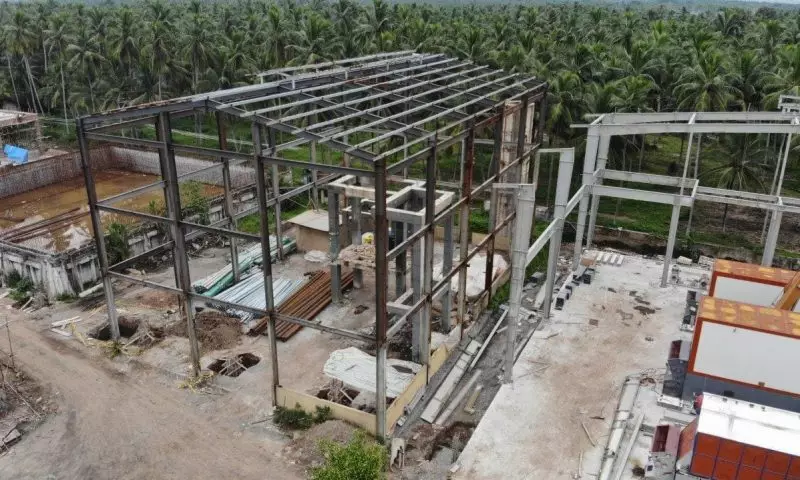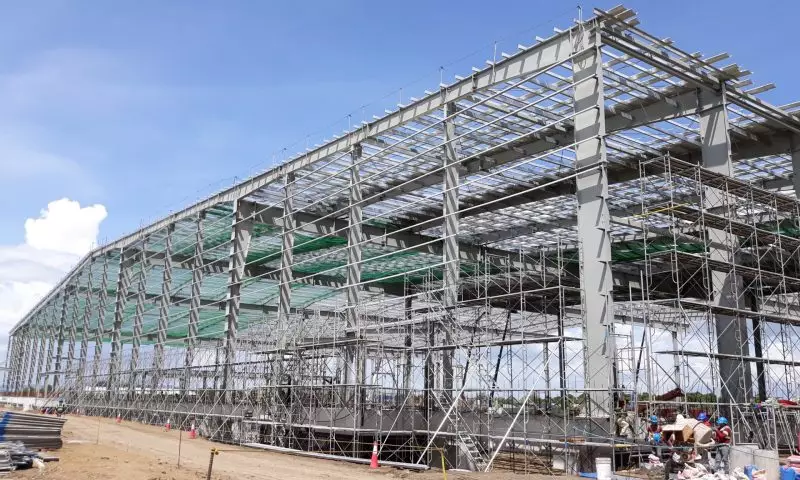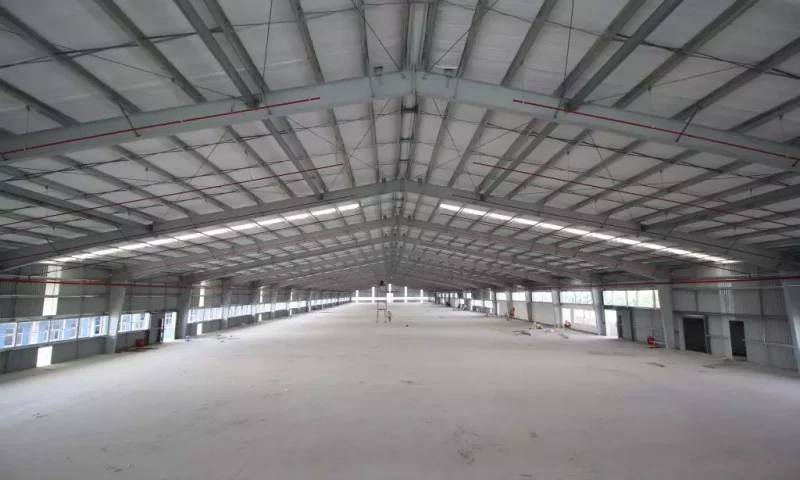Reading structural steel drawings is a crucial skill for understanding construction blueprints thoroughly. When interpreting these structural steel drawings, you need to meticulously examine each part of the structure described in the drawing to ensure a precise understanding of its content. Join Pebsteel in exploring the detailed process of reading structural steel drawings in the article below.
See more: Erection of Structural steel
1. What are structural steel drawings?
A structural drawing is a technical document that comprehensively describes the construction of buildings, factories, etc. guiding the construction process. Typically, architectural drawings are created before structural drawings, and in some cases, structural drawings may be based on the foundation of architectural drawings.
Structural steel drawings are documents illustrating how steel materials are combined during the construction process. They play a guiding role for contractors in selecting construction materials. Essentially, structural steel drawings are documents that specify the precise locations of each type of steel material used in the construction project. Understanding the information presented in structural steel drawings helps investors gain a clear understanding of the project and provides a basis for making appropriate decisions during the construction and management processes.
A structural steel drawing comprises the following main components:
- Structure Height: Describes the height and structure of the external walls of the construction.
- Structural Plan: Illustrates the positions of various floors, foundations, and the roof of the building. Additionally, it may pinpoint specific locations where structural elements, in this case, structural steels, are placed.
- Contractor’s Ideas and Construction Desires: This section depends on the specific requirements of the contractors, representing their preferences and construction plans.
See more: What is a Steel structure? Main type of steel structure building!

A structural steel drawing is a document illustrating how steel materials are assembled during the construction process.
2. Guidelines for detailed reading of structural steel drawings
2.1. Reading structural steel design guidelines
Every structural design drawing is accompanied by an instructional section; therefore, reading and understanding this part is crucial. After reading the structural steel design instructions, you should pay attention to the following:
- Understanding Specific Structural Requirements
- Mastering emphasized content in the description part, including information about content, materials, and quality.
- Learning about technical measures required for implementation
- Understanding technical standards and structures while also staying informed about the applicable standards.
See more The Process of Structural Steel And Plate Fabrication
2.2. Reading fundamental layout drawings
When reading fundamental layout drawings, you should thoroughly understand the following:
- Foundation Details: Factors such as the depth of the foundation, positioning axis values, types, and distinctive points of the foundation are crucial. Pay attention to features and openings integrated into the foundation for different types of structures.
- Architectural Drawings Analysis: Study architectural drawings to ensure all axes correspond to the foundation. Additionally, consider walls that are not supported by the foundation and evaluate whether they can be replaced with pile beams. Check for any changes in the shape and structure of the foundation, along with the use of different foundation devices.
- Comparison of Plan and Section of the Foundation: Compare the plan and section of the foundation to identify any changes in ground elevation along with the top of the foundation and understand how to address these changes. Information about the position of the plan, height, and quantity of reserve holes, along with embedded parts in the foundation, needs to be clearly understood.
- Understanding Foundation Forms and Practices: Mastery of knowledge regarding the forms and practices of the foundation, as well as understanding the dimensions and reinforcement of each component, is crucial. If there are still unclear issues, repeat the above process and document any unresolved tasks.
See more: Steel Arch Structure: Classifications And Applications
2.3. Reading detailed structural layout drawings
A detailed structural layout drawing includes elevation views of the structure, sectional, or standard drawings. To comprehend it thoroughly, you need to grasp the structure’s form, the plane’s position, and the height of the main components. Simultaneously, combining it with architectural drawings provides a comprehensive view of the position and height of each component.
Subsequently, you need to classify the main components by integrating information from sectional, standard, and detailed drawings. During this process, you need to understand and identify both similarities and differences among them. Specifically, you should capture both commonalities and distinctions in the structure of each component node and embedded parts.
See more: Common Types Of Structural Steel In Construction
2.4. Reading detailed structural drawings
Firstly, you need to verify the position, elevation, and quantity of components on the structural plane to ensure alignment with detailed drawings. Simultaneously, it is necessary to check for any discrepancies in elevation, dimensions, or position. Additionally, you should understand the connection methods between components to ensure that the position or elevation is maintained while identifying any potential conflicts with other components. Detailed information about accessories or steel bars within the component and the main content should also be clearly understood. By comparing with the material list, you can verify the aforementioned points.
The final steps are summarizing the construction structural drawing, organizing the documentation, reviewing previously mentioned issues, and providing any necessary recommendations.

To understand the structural steel drawing, customers are required to meticulously follow a systematic approach, adhering to each step methodically.
3. Essential skills to read structural steel drawings
3.1. Understand the project’s scale
To interpret a structural steel drawing, the skill of reading and understanding the project’s scale based on the proportions in the drawing is essential. Each dimension on the drawing corresponds to a larger value in reality; hence, the drawing scale precisely indicates the dimensions of specific structures within the project.
Comprehending and estimating various scales may pose a challenge for newcomers. A crucial first step in estimating the project scale is to gain a thorough understanding of the types of scales used. You may also engage in direct communication with engineers or instructors for a more detailed explanation of determining the actual dimensions of the project.
3.2. Understand the meaning of symbols and annotations
To comprehend a structural steel drawing, you need to be well-versed in the symbols and understand their meanings in the drawing. For instance, certain symbols may represent sections or elevations. Symbols commonly include circles, rectangles, triangles, and others. Most symbols maintain consistent interpretations with predetermined meanings across various engineering disciplines. Therefore, to decipher these symbols, it is essential to understand and memorize their interpretations.
Legend symbols are a specific type of icon used in structural drawings, typically placed in the margins of the drawing. Legend symbols serve to provide additional information related to construction procedures.
3.4. Understand the circled number
The circled numbers are utilized to emphasize critical information on the drawing. This indicates that there is additional detailed information located in another section of the drawing. Due to the often reduced scale of drawings, which is insufficient for detailed explanations, all detailed explanations are placed elsewhere. When you encounter a circled number, it serves as a prompt, directing attention to the fact that there is other detailed information that requires examination.
3.5. Identify and understand the abbreviation
Abbreviations are commonly employed similarly to symbols, facilitating the convenient representation of construction information on the drawing. For non-specialists, comprehending and memorizing the entirety of abbreviations can be challenging. However, customers can undertake research and commit to memorizing some of the most frequently used abbreviations. In instances where unfamiliar abbreviations arise, it is better to seek guidance from an engineer for clarification.

Drawing readers need to possess several essential skills
4. Conclusion
The article above provides guidelines for reading detailed structural steel drawings along with some necessary skills for understanding the drawings. For comprehensive solutions related to pre-engineered steel buildings and structural steels, please contact Pebsteel by phone at +66 2258 4639-41 or by email immediately at thaisales@pebsteel.com
*** This article is intended to provide general information about the pre-engineered steel building and steel structure industry only. For further details or clarification based on your needs, please contact Pebsteel directly.













